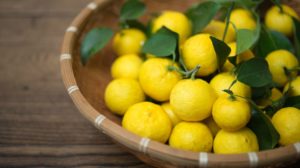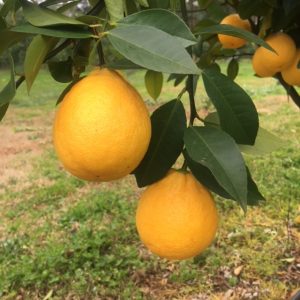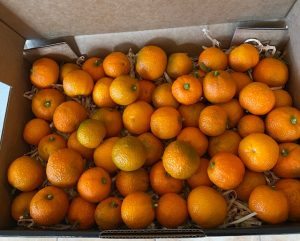YUZU

Yuzu is a super fragrant citrus that is just amazing. It is an important part of Japanese cuisine and culture.
It’s flavour is hard to describe but lands somewhere between a mandarin, lime and grapefruit.
It is used just like a lemon and has flavourful tart juice but it is the zest of fresh yuzu that really showcases the fruit’s full aroma. Apart from it’s culinary uses the fresh yuzu is traditionally popped into baths where it’s aromatic properties improve mood and the oils soften the skin and are thought to aid in the resistance to colds.
Harvest is from late April with the peak in May each year.
SUDACHI

Fresh Sudachi is a citrus gem that adds a burst of lively flavour. Native to Japan, Sudachi is celebrated for its unique blend of tartness, sweetness, and a subtle hint of bitterness. It is much more subtle than yuzu and acts as a flavour enhancer. Don’t be disappointed in the lack of aroma, these little green gems amp up the flavour of almost everything, chicken, seafood, mushrooms, soba, ramen, the list is endless….
Harvest is from early April each year.
BERGAMOT

Fresh Bergamot is another wonderful aromatic citrus but this one comes from Calabria in Italy. It is the size of an orange with a rounded base with a small point and a conical top. Bergamot can be picked green, green/orange or fully orange. We prefer to wait until the fruit is fully ripe before picking as the flavour is more balanced. It’s often used in fragrances and was one of the ingredients of the first ever ‘Eau de Cologne
‘ in 1709 as well as contributing the citrus notes in Earl Grey Tea. The Greeks make a wonderful bergamot marmalade but it’s powerful flavour and aroma mean that it is usually combined with orange to balance out the intensity. It’s a very unique citrus.
Harvest is from early June each year.
Chinotto

Chinotto is a small bitter orange coloured fruit – usually no bigger than a golf ball. It grows quite differently to our other citrus and is late to harvest. Like the bergamot it is of Italian origin and is not generally eaten as a fresh fruit due to it’s sour, bitter nature but is used extensively in Italy as a flavouring. The most well known of it’s uses is in the composition of Campari and also the Italian soft drink that bears it’s name. The fruit makes lovely marmalade and the essential oils are used to flavour gin. In Italy, Chinotto is also candied whole and stored in maraschino and consumed as a dessert.
Harvest is from mid July each year.
